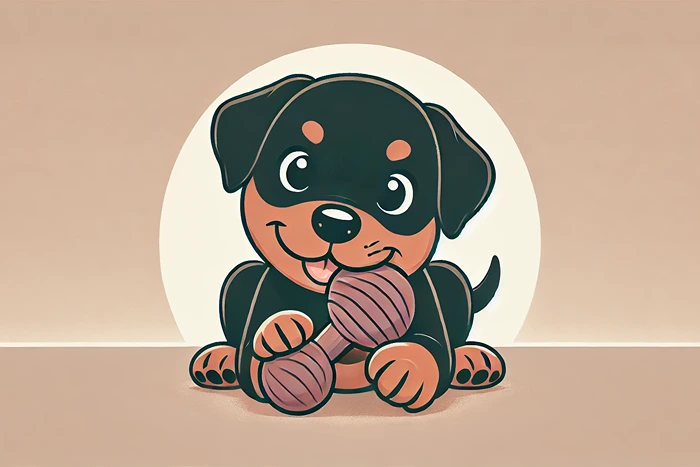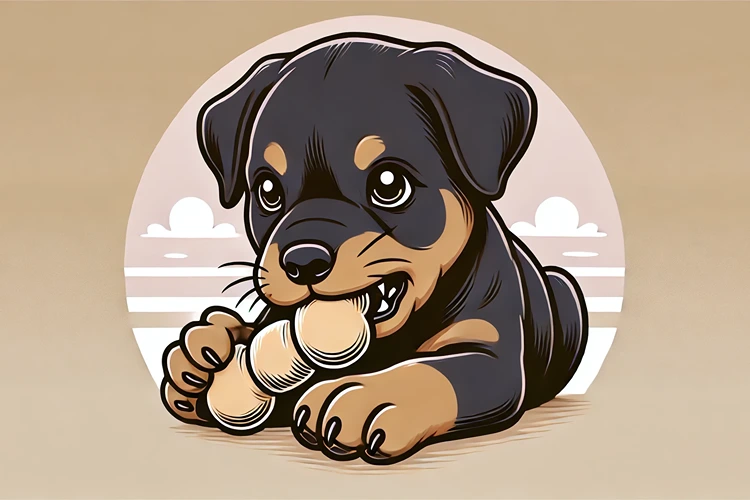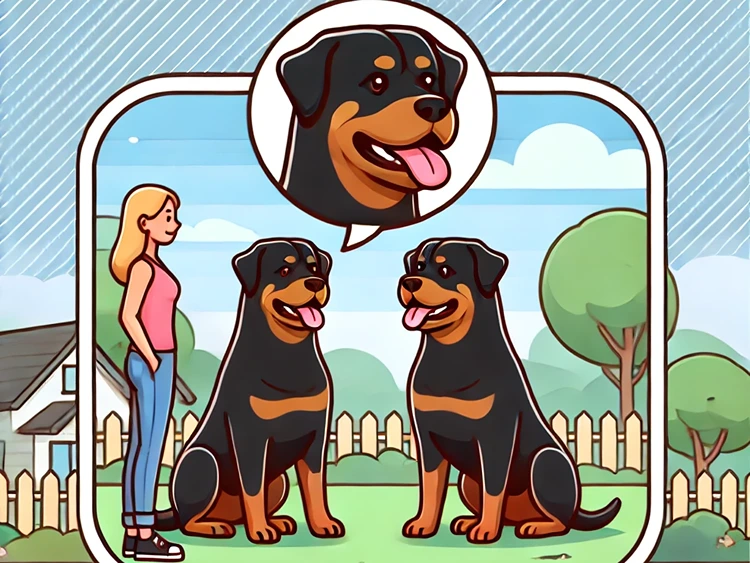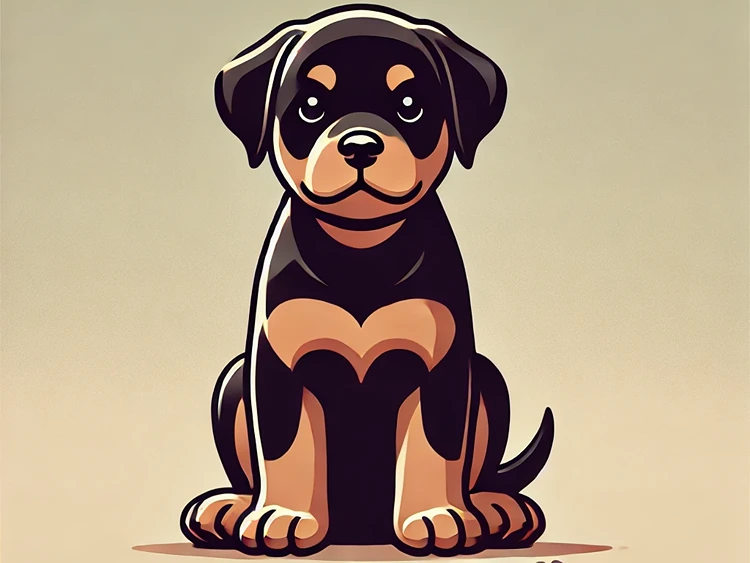Rottweiler puppies go through a variety of developmental stages, but one that often catches new owners by surprise is the teething phase. This natural process can be challenging for both the pup and the owner, with chewing, discomfort, and behavior changes being common. Understanding the teething phases, how to help your pup through them, and what to expect is key to ensuring a smoother experience. Let’s dive into everything you need to know about Rottweiler puppy teething.
When Does Teething Start in Rottweiler Puppies?
Most Rottweiler puppies begin teething around 3 to 4 weeks of age, though the real action starts when they hit 3 to 4 months. This period can last several months, with most puppies finishing teething by 6 to 8 months. While it can seem like an eternity for both you and your pup, knowing what’s happening at each stage helps make the process more manageable.
Paw-some Tip:
Begin introducing soft chew toys when your Rottweiler puppy is around 3 months old. This helps soothe their gums and provides a safe outlet for their desire to chew.
How to Spot the Teething Symptoms?

As your Rottweiler pup enters the teething phase, you’ll notice several tell-tale signs. These include:
- Increased Chewing: Puppies will chew on anything they can get their paws on, from shoes to furniture, to relieve discomfort.
- Drooling: Teething often causes an uptick in drooling, which is completely normal.
- Irritability: Some puppies become more irritable or restless due to gum pain.
- Loss of Appetite: Because chewing can be painful, your puppy may avoid eating harder kibble.
- Bleeding Gums: You might notice minor bleeding when your puppy is losing teeth.
What Happens in the Early Teething Phase?
The early teething phase typically begins around 3 to 4 months old. At this stage, your Rottweiler puppy will start losing their baby teeth as their adult teeth begin to push through. This can be an uncomfortable process, and it’s not unusual for puppies to chew obsessively to ease their gum pain. During this phase, it’s crucial to offer safe chewing alternatives to prevent damage to your belongings.
Paw-some Tip:
Frozen washcloths or specially designed teething toys can be a soothing way to help your Rottweiler puppy manage gum discomfort during this stage.
Why Do Rottweiler Puppies Chew More During Teething?
Chewing helps relieve the pressure and discomfort caused by new teeth breaking through the gums. However, your pup doesn’t understand the difference between your shoes and a chew toy. Providing proper chew toys and redirecting their attention will help them form good habits early on. This is a critical time to set boundaries for what’s appropriate for chewing and what isn’t.
How to Care for Your Rottweiler Puppy’s Teeth?
Just like with humans, dental care is vital for your puppy’s long-term health. Start brushing their teeth early to prevent plaque buildup and other dental issues. Use dog-specific toothpaste and a soft brush to keep their gums and teeth healthy as they transition from baby to adult teeth. Getting them used to this process early will make it easier to maintain good dental hygiene as they grow.
Rottie Stats:
According to the American Veterinary Medical Association, 80% of dogs show signs of periodontal disease by the age of 3. Starting dental care early can significantly reduce this risk.
What to Expect During the Adult Teeth Phase
Between 5 to 6 months, your Rottweiler will begin to develop their adult teeth. This is another intense chewing phase, and you may notice an uptick in biting behavior as they test out their new, stronger teeth. It’s important to continue guiding them toward appropriate chew toys and away from things they shouldn’t bite, like furniture or your hands.
As the adult teeth settle in, you’ll see less chewing and drooling. By 8 months, most Rottweilers will have all 42 of their adult teeth, and teething will be a thing of the past.
How Can You Ease Your Rottweiler’s Discomfort?
Your Rottweiler puppy’s teething discomfort can be managed with the right tools and strategies. Here are some ways you can help:
- Cold Chew Toys: Chewing on cold toys or even a frozen washcloth can provide immediate relief for sore gums.
- Teething Gels: Ask your vet about safe teething gels that can be applied to your puppy’s gums to numb the pain temporarily.
- Frequent Breaks: Sometimes, the discomfort can make your puppy more restless. Ensure they have plenty of time for naps and quiet spaces to rest.
- Provide Appropriate Chew Toys: Soft rubber toys, puppy teething rings, and even edible dental chews are great options to keep them entertained and ease teething pain.
Paw-some Tip:
Make sure you rotate your Rottweiler puppy’s chew toys regularly. New textures and shapes will keep them engaged and less likely to chew on furniture or shoes!
Are There Any Health Risks During Teething?
Though teething is a natural process, there are a few health concerns that you should be aware of:
- Broken Teeth: If your Rottweiler chews on hard objects, they could crack a tooth, leading to pain and potential dental procedures.
- Infection: In rare cases, loose baby teeth or adult teeth that don’t grow in correctly could lead to infection. Look for signs of swelling, bleeding, or a foul odor coming from your puppy’s mouth.
- Retained Baby Teeth: Sometimes, a baby tooth doesn’t fall out when the adult tooth grows in. This can cause overcrowding and discomfort, requiring a vet to remove the retained tooth.
When Should You Be Concerned About Your Puppy’s Teething?
While most teething symptoms are mild, there are certain red flags that could indicate something more serious:
- Excessive drooling beyond what’s typical during teething.
- Blood in their saliva or gums that doesn’t seem to heal.
- Persistent bad breath, which could point to an infection.
- Difficulty eating or excessive pain while chewing.
If you notice any of these symptoms, it’s a good idea to consult your vet to rule out dental issues or infections.
How Long Does the Teething Process Last?
For most Rottweiler puppies, the teething phase spans about five months, starting around three months old and wrapping up by eight months. However, every pup is unique, and some may experience teething a little earlier or later. During this time, patience is key—both for you and your puppy!
Rottie Stats:
Rottweilers typically get their full set of 42 adult teeth by 6 to 8 months. In comparison, smaller breeds may develop their adult teeth as early as 5 months.
Common Teething Phases in Rottweilers
| Age Range | Teething Stage | Common Behavior | Recommended Action |
|---|---|---|---|
| 3 to 4 Months | Baby Teeth Start Falling Out | Increased Chewing, Drooling, Restlessness | Introduce Soft Chew Toys, Monitor Gums |
| 4 to 5 Months | Adult Teeth Begin to Emerge | More Intense Chewing, Mild Gum Bleeding | Provide Cold Teething Toys, Start Gentle Tooth Brushing |
| 5 to 6 Months | Most Adult Teeth Are In | Biting and Chewing on Harder Objects | Offer Dental Chews, Continue Training Proper Chewing Behavior |
| 6 to 8 Months | Teething Phase Ends | Chewing Behavior Subsides | Maintain Dental Care Routine, Regular Vet Visits |
What Happens After the Teething Phase?
Once the teething phase is over, your Rottweiler will have their full set of adult teeth, and the need to chew on everything should subside. However, it’s still important to maintain good dental hygiene habits and provide appropriate chew toys to keep their teeth healthy and strong.
Even after teething, adult Rottweilers enjoy chewing as a way to relieve stress, boredom, or anxiety. Make sure to have a variety of toys on hand to satisfy their natural chewing instincts.
How to Prevent Long-Term Dental Issues in Rottweilers?
Proper dental care doesn’t end after the teething phase. In fact, maintaining your Rottweiler’s dental health is an ongoing commitment. By establishing good habits early on, you can prevent many common dental problems such as plaque buildup, gum disease, and tooth decay.
- Brush Their Teeth Regularly: Ideally, you should brush your Rottweiler’s teeth several times a week using dog-friendly toothpaste.
- Dental Chews and Toys: Provide dental chews designed to scrape off plaque as they gnaw on them. These not only keep their teeth clean but also satisfy their need to chew.
- Regular Vet Checkups: Routine dental exams during your vet visits are essential. Your vet can check for early signs of dental issues and provide professional cleanings if needed.
- Avoid Hard Bones: Contrary to popular belief, hard bones can lead to cracked teeth. Instead, offer softer chew options like rubber toys or edible chews.
Paw-some Tip:
Introduce tooth brushing slowly. Start by gently rubbing your puppy’s gums with your finger, then graduate to using a soft-bristled dog toothbrush.
Does Teething Affect Rottweiler Training?
The teething phase can present some unique challenges when it comes to training. Your puppy may become more distracted due to gum pain, which can make obedience training sessions less effective. To keep things productive, adjust your training sessions around your puppy’s needs during teething.
- Keep training sessions shorter to accommodate their discomfort.
- Use soft, chewy treats that are easy for them to eat without causing pain.
- Incorporate more breaks to give them time to chew on their toys and relieve discomfort.
While teething can temporarily slow down their training progress, it’s important to stay patient. With consistency and understanding, your Rottweiler will continue to learn, even during this uncomfortable phase.
Why Is Chewing a Lifelong Habit for Rottweilers?
Chewing isn’t just a teething-related behavior—it’s a lifelong habit that plays a big role in your Rottweiler’s mental and physical health. As they grow older, they will still crave the satisfaction of chewing, which helps reduce boredom, stress, and anxiety. Providing safe and appropriate toys is essential, not just during teething but throughout their adult life.
Remember, a Rottweiler with the right chew toys is less likely to chew on things they shouldn’t, saving your furniture, shoes, and other belongings from destruction!
FAQs
Wrapping Up
Teething is a crucial developmental stage for every Rottweiler puppy, and while it can be challenging, understanding the process makes it more manageable. By knowing when to expect teething to start, what signs to look out for, and how to care for your pup’s gums and teeth, you’re setting the foundation for a healthy, well-adjusted dog. Be patient during this phase, provide plenty of appropriate chew toys, and maintain good dental hygiene habits.
As your Rottweiler grows out of teething, don’t forget that dental care remains essential. Establishing these routines early on will benefit their overall health long into adulthood. Whether it’s brushing their teeth, offering dental chews, or visiting the vet regularly, every small step you take now will keep your Rottie’s smile strong and healthy.




